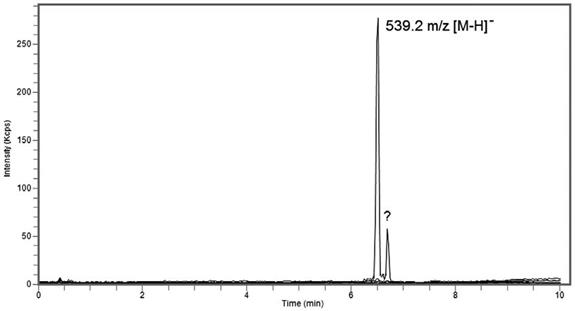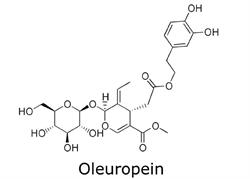Oleuropein in Olive Leaves Extract Analyzed with LCMS - AppNote
January 6, 2014
/
/
/
/
/
High Efficiency Using a near-UHPLC Column for Oleuropein
In this Application Note, the Analyte Peak is symmetrical and well Retained while the results were very reproducible (%RSD = 0.06 for Retention Times). This Method can be used to analyze and evaluate the extraction of Olive Leaves.
According to the literature, Olive Leave Extracts should contain the following compounds: Oleuropein, Hydroxytyrosol, Verbascoside, Apigenin, Luteolin-7-O-Glucoside, and Tyrosol [1].
Column: Cogent Bidentate C18 2.o, 2.2μm, 120Å
Catalog No.: 40218-05P-2
Dimensions: 2.1 x 50mm
Mobile Phase:
--A: DI Water with 0.1% Formic Acid (v/v)
--B: Acetonitrile with 0.1% Formic Acid (v/v)
Gradient:
Post Time: 3 minutes
Injection vol.: 1μL
Flow rate: 0.3mL / minutes
Detection: ESI – NEG - PerkinElmer Flexar SQ 300 Mass Spectrometer
Sample Preparation: Commercial Olive Leaves Extract was dissolved in DI Water at a concentration 10ppm.
t0: 0.6 minutes
Note: Olive Leaves are food byproducts (after pruning of Olive Trees) which are full of bioactive compounds. These compounds are potent polyphenols, which show antibacterial, antiviral, anti-cancer, anti-inflammatory, and antioxidant activities. Different extraction procedures are used for selective extraction of polyphenols from olive leaves. An analytical method to monitor and evaluate the resulting extract is needed.
[1] J.E. Hayes, P. Allen, N. Brunton, M.N. O’Grady, and J.P. Kerry, Food Chemistry, 126, (2011) 948–955.

Attachment
No 284 Oleuropein in Olive Leaves Extract Analyzed with LCMS pdf 0.2 Mb Download File
In this Application Note, the Analyte Peak is symmetrical and well Retained while the results were very reproducible (%RSD = 0.06 for Retention Times). This Method can be used to analyze and evaluate the extraction of Olive Leaves.
According to the literature, Olive Leave Extracts should contain the following compounds: Oleuropein, Hydroxytyrosol, Verbascoside, Apigenin, Luteolin-7-O-Glucoside, and Tyrosol [1].
Peak:
Oleuropein 539.2 m/z [M-H]–
Column: Cogent Bidentate C18 2.o, 2.2μm, 120Å
Catalog No.: 40218-05P-2
Dimensions: 2.1 x 50mm
Mobile Phase:
--A: DI Water with 0.1% Formic Acid (v/v)
--B: Acetonitrile with 0.1% Formic Acid (v/v)
Gradient:
| Time (minutes) | %B |
| 0 | 5 |
| 3 | 15 |
| 4 | 15 |
| 6 | 30 |
| 7 | 30 |
| 11 | 95 |
| 14 | 95 |
| 15 | 5 |
Injection vol.: 1μL
Flow rate: 0.3mL / minutes
Detection: ESI – NEG - PerkinElmer Flexar SQ 300 Mass Spectrometer
Sample Preparation: Commercial Olive Leaves Extract was dissolved in DI Water at a concentration 10ppm.
t0: 0.6 minutes
Note: Olive Leaves are food byproducts (after pruning of Olive Trees) which are full of bioactive compounds. These compounds are potent polyphenols, which show antibacterial, antiviral, anti-cancer, anti-inflammatory, and antioxidant activities. Different extraction procedures are used for selective extraction of polyphenols from olive leaves. An analytical method to monitor and evaluate the resulting extract is needed.
[1] J.E. Hayes, P. Allen, N. Brunton, M.N. O’Grady, and J.P. Kerry, Food Chemistry, 126, (2011) 948–955.

Attachment
No 284 Oleuropein in Olive Leaves Extract Analyzed with LCMS pdf 0.2 Mb Download File


